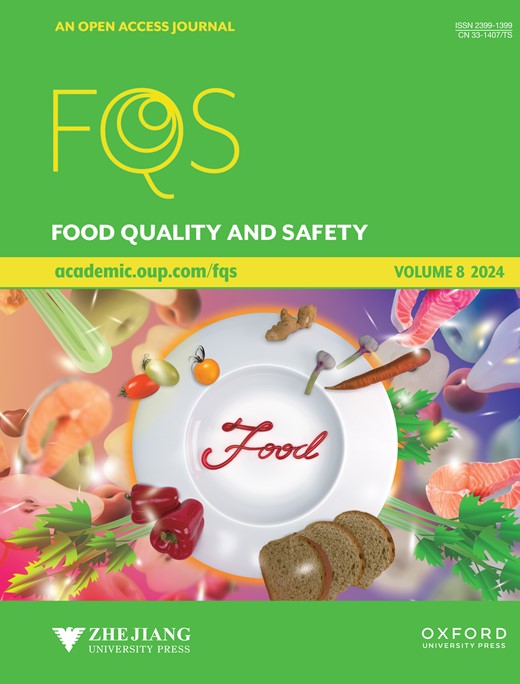Comprehensive characterization and detection of nut allergens in bakery foods using Q–TOF mass spectrometry and bioinformatics
IF 4.4
3区 农林科学
Q2 FOOD SCIENCE & TECHNOLOGY
引用次数: 0
Abstract
Food allergy is a growing health issue worldwide and the demand for sensitive, robust and high throughput analytical methods is rising. In recent years, mass spectrometry–based methods have been establishing its role in multiple food allergen detection. In the present study, a novel method was developed for the simultaneous detection of almond, cashew, peanut and walnut allergens in bakery foods using liquid chromatography–mass spectrometry. Protein unique to theses four ingredients were extracted, followed by trypsin digestion, quadrupole time–of–flight (Q–TOF) mass spectrometry and bioinformatics analysis. Raw data were processed by de–novo sequencing module plus PEAKS DB (database search) module of the PEAKs software to screen peptides specific to each nut species. Thermal stability and uniqueness of these candidate peptides were further verified using triple quadrupole mass spectrometry (QQQ–MS) under multiple reaction monitoring (MRM) mode. Each nut species was represented by four peptides, all of which were validated for label–free quantification (LFQ). Calibration curves were constructed with good linearity and correlation coefficient (r2) greater than 0.99. The limits of detection (LODs) were determined to range from 0.11 mg/kg to 0.31 mg/kg, and were compared with the reference doses proposed by Voluntary Incidental Trace Allergen Labelling (VITAL). The recoveries of the developed method in incurred bakery food matrices ranged from 72.5% to 92.1% with relative standard deviations (RSD) of less than 5.2%. Commercial bakery food samples detection confirmed existence of undeclared allergens. In conclusion, this method shed light on the field of qualitative and quantitative detection of trace levels of nut allergens in bakery foods.利用 Q-TOF 质谱法和生物信息学全面表征和检测烘焙食品中的坚果过敏原
食物过敏是全球日益严重的健康问题,对灵敏、可靠和高通量分析方法的需求也在不断增加。近年来,基于质谱的方法在多种食物过敏原检测中发挥了重要作用。本研究采用液相色谱-质谱法开发了一种新型方法,用于同时检测烘焙食品中的杏仁、腰果、花生和核桃过敏原。首先提取这四种成分特有的蛋白质,然后进行胰蛋白酶消化、四极杆飞行时间(Q-TOF)质谱分析和生物信息学分析。原始数据由 PEAKs 软件的 de-novo 测序模块和 PEAKS DB(数据库搜索)模块处理,以筛选出每种坚果的特异肽。在多反应监测(MRM)模式下,使用三重四极杆质谱(QQQ-MS)进一步验证了这些候选肽的热稳定性和独特性。每种坚果由四种肽段代表,所有这些肽段都经过了无标记定量(LFQ)验证。构建的校准曲线线性良好,相关系数(r2)大于 0.99。检出限(LOD)范围为0.11 mg/kg 至 0.31 mg/kg,并与自愿性痕量过敏原标签(VITAL)提出的参考剂量进行了比较。该方法在焙烤食品基质中的回收率为 72.5% 至 92.1%,相对标准偏差(RSD)小于 5.2%。商业烘焙食品样品的检测证实了未申报过敏原的存在。总之,该方法为烘焙食品中痕量坚果过敏原的定性和定量检测提供了启示。
本文章由计算机程序翻译,如有差异,请以英文原文为准。
求助全文
约1分钟内获得全文
求助全文
来源期刊

Food Quality and Safety
FOOD SCIENCE & TECHNOLOGY-
CiteScore
7.20
自引率
1.80%
发文量
31
审稿时长
5 weeks
期刊介绍:
Food quality and safety are the main targets of investigation in food production. Therefore, reliable paths to detect, identify, quantify, characterize and monitor quality and safety issues occurring in food are of great interest.
Food Quality and Safety is an open access, international, peer-reviewed journal providing a platform to highlight emerging and innovative science and technology in the agro-food field, publishing up-to-date research in the areas of food quality and safety, food nutrition and human health. It promotes food and health equity which will consequently promote public health and combat diseases.
The journal is an effective channel of communication between food scientists, nutritionists, public health professionals, food producers, food marketers, policy makers, governmental and non-governmental agencies, and others concerned with the food safety, nutrition and public health dimensions.
The journal accepts original research articles, review papers, technical reports, case studies, conference reports, and book reviews articles.
 求助内容:
求助内容: 应助结果提醒方式:
应助结果提醒方式:


